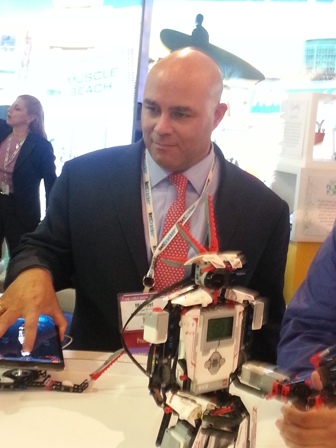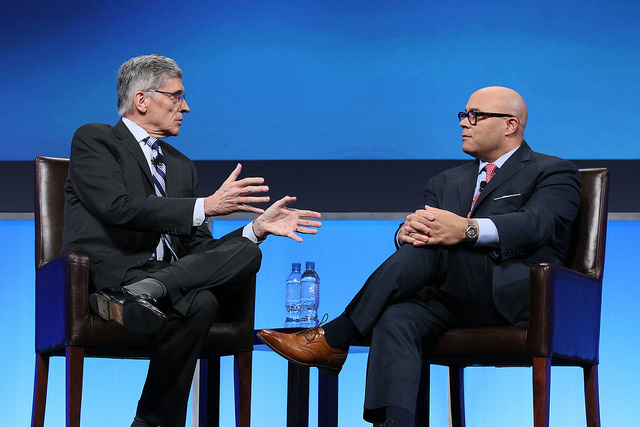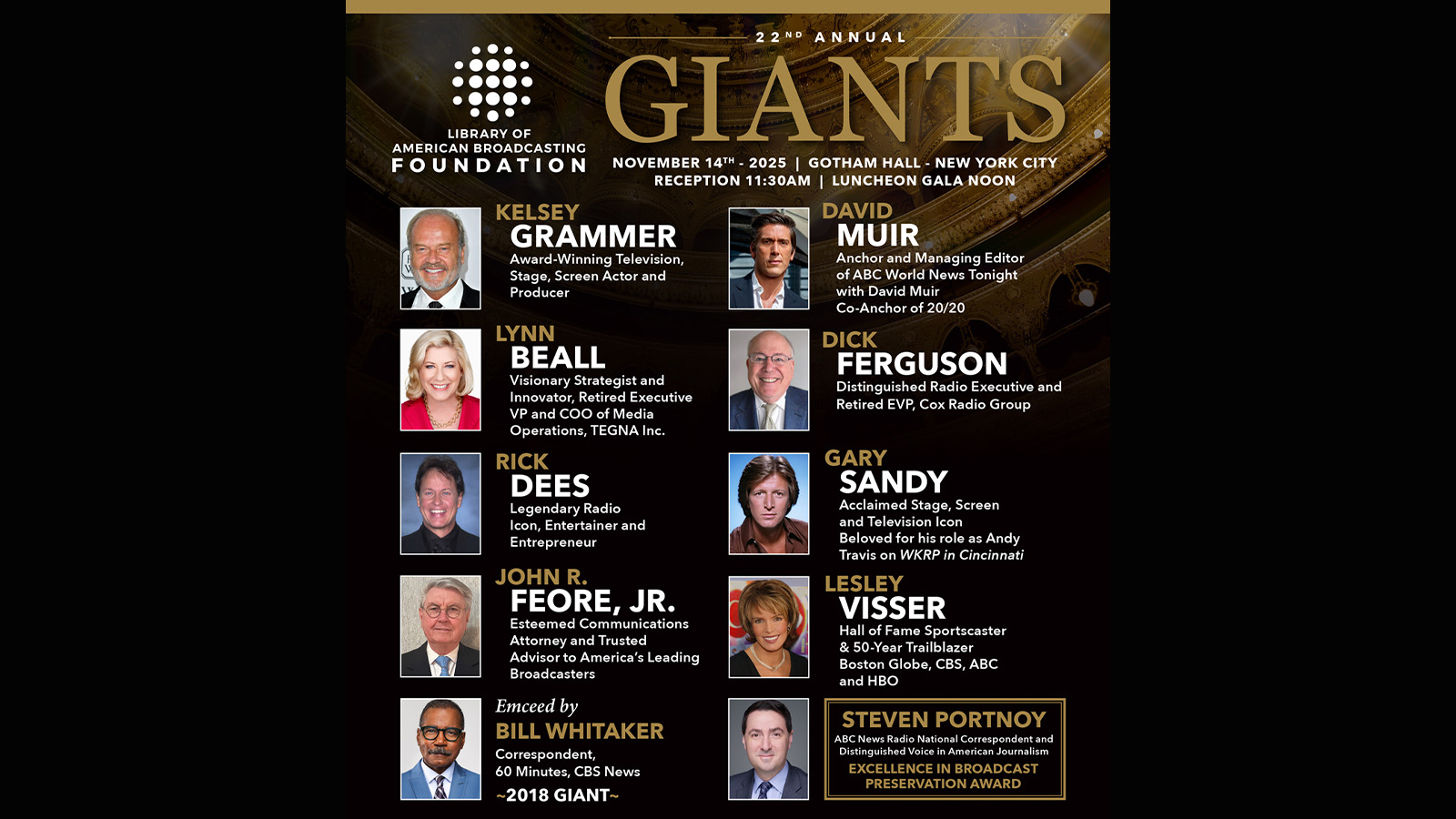Comcast’s Tech Plans, ‘Gigasphere’ Establish Direction at Cable Show
LOS ANGELES—Comcast had one of the largest and most heavily trafficked booths in this year’s Cable Show exhibit hall; an unusual presence since operators are typically “buyers” not showcased “sellers” at such events. But now, with Comcast’s product and service decisions dominating the industry’s direction, the company’s visions for its X1 platform and network architecture are of great interest to other operators as well as vendors who will build the products.

NCTA President Michael Powell checks out new technology on the floor of the 2014 Cable Show. Photo by Gary Arlen
Hence Comcast’s booth held immense interest, as it showcased enhanced navigation/guide features (including “Voice Guidance” for visually impaired, a Spanish-language guide and a Kids’ Guide that integrates age-specific ratings. Comcast also displayed Xfinity Home Apps for utility management and “Family Point,” a TV-centric X1 version of a mobile app that allows family members to message each other. Other demonstrations emphasized on-demand video features and cloud-based services for voice and video, which Comcast said will be available by early 2015.
Comcast also demonstrated a new service that will let X1 subscribers stream video from their smartphones to home TV receivers anywhere, a “semi-Skype”-like offering that will let out-of-town grandparents watch kids’ softball games or parties.
DOCSIS=‘GIGASPHERE’
With the looming merger of Comcast and Time Warner Cable—another big topic through the annual convention of the National Cable & Telecommunications Association, which took place here April 29-May 1—the booth’s focus on advanced products offered a glimpse of competitive features that may become part of a near-nationwide footprint.
Comcast also unveiled expanded WiFi plans, with a target of eight million hotspots by year-end, underscoring the importance of out-of-home WiFi as part of its offering.
Get the TV Tech Newsletter
The professional video industry's #1 source for news, trends and product and tech information. Sign up below.
Meanwhile, a fundamental building block of cable’s digital evolution, the DOCSIS 3.1(Data Over Cable Service Interface Specification) broadband platform got a new identification at the show: “Gigasphere.” Although cable engineers will continue to use the DOCSIS acronym, the new branding is intended to become a promotional name as the cable industry accelerates its all-IP transition, which includes a goal of data capacities up to 10 Gbps downstream and 2 Gbps upstream. NCTA, CableLabs, Cable & Telecommunications Association for Marketing (CTAM) and Cable Europe are supporting the new “Gigasphere” branding, which in part is positioned to compete against emerging services such as Google Fiber’s 1 Gig network and AT&T’s U-verse “Gigapower.”
Although the similar names may generate market confusion, NCTA President/CEO Michael Powell expects the Gigasphere brand will enhance cable’s position as a “next-generation technology.”
“We must help consumers understand its potential to dramatically enhance our communities, our world, and our lives,” Powell said. “Gigasphere stands for incredibly fast access to the Web, the world, and the things that matter most to broadband users.”

FCC Chairman Tom Wheeler (L) and NCTA President Michael Powell at the 2014 Cable Show
During the Cable Show, Cox Communications unveiled a “broadband roadmap” that envisions 1 Gbps speeds to all residential subscribers. Cox CEO Pat Esser said that the service will begin in selected markets this spring.
COMPETITION FROM OVER-THE-TOP
Cable’s concern with competition from online over-the-top video percolated through several sessions. At a keynote panel, Arris President/CEO Bob Stanzione assured attendees that the two video delivery systems can coexist, noting that STB makers can and will integrate OTT reception into their equipment when the market needs it.
“It’s about business arrangement, not a matter of technology,” he said.
Elsewhere on the technology front, RDK Management, the joint venture that manages the Reference Design Kit project—heavily backed by Comcast and Time Warner Cable—said its v2.0 software is almost ready for field testing, with the prospect of access beyond set-top boxes to modems, routers and converged gateways. Cisco will make customer premise equipment (CPE) routing software available in open-source format for the project.
The Cisco offer underscored a predominant factor of the Cable Show: it has become a software show, with traditional hardware exhibits overshadowed by software for everything from system monitoring to customized, dynamic advertising delivery.
For example, This Technology unveiled its 2.1 version of Trajectory, a dynamic ad insertion (DAI) platform that supports an enhanced placement management system and data reporting. Another company, Black Arrow, has morphed its DAI system to support Nielsen’s On Demand Commercial Ratings, a measurement methodology that Comcast is testing.
With about 10,000 attendees, nearly a 20 percent drop from recent years, the Cable Show included policy fireworks, largely stemming from FCC Chairman Tom Wheeler’s speech in the cable industry’s obligations under forthcoming network neutrality rules.
Gary Arlen, a contributor to Broadcasting & Cable, NextTV and TV Tech, is known for his visionary insights into the convergence of media + telecom + content + technology. His perspectives on public/tech policy, marketing and audience measurement have added to the value of his research and analyses of emerging interactive and broadband services. Gary was founder/editor/publisher of Interactivity Report, TeleServices Report and other influential newsletters; he was the long-time “curmudgeon” columnist for Multichannel News as well as a regular contributor to AdMap, Washington Technology and Telecommunications Reports; Gary writes regularly about trends and media/marketing for the Consumer Technology Association's i3 magazine plus several blogs.

